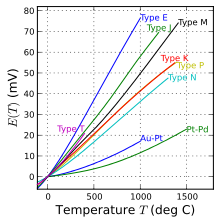Sanity Check
I have a number of customers who want their calibrations to meet the requirements of AMS2750E. They send in their calibrators made by Fluke, PIE, Altek, Martel, and others and expect better than manufacturer’s specifications to be met. The reason for this is that AMS2750E does not differentiate between thermocouple types. If you google thermocouple calibrators you will notice that the specifications are different for different thermocouple types and ranges. To understand why this is, we need to think about how thermocouples work.
The Thermoelectric effect
The thermoelectric effect is the direct conversion of temperature differences to electric voltage and vice versa. A thermoelectric device creates a voltage when there is a different temperature on each side. (Thermoelectric effect, n.d.)
The Seebeck effect is the conversion of heat directly into electricity at the junction of different types of wire. It is named after the Baltic German physicist Thomas Johann Seebeck, who in 1821 discovered that a compass needle would be deflected by a closed loop formed by two different metals joined in two places, with a temperature difference between the joints. This was because the electron energy levels in each metal shifted differently and a potential difference between the junctions created an electrical current and therefore a magnetic field around the wires. (Thermoelectric effect, n.d.)
So, when we create a junction between two metal alloys we can use this junction to measure temperature. Different junctions of different alloys will produce different voltages, and even for the same combination of alloys the voltage per degree will change based on the temperature range being measured.
Thermocouple calibrators then, need to do three things well:
· Measure/Source voltage
· Calculate the voltage per degree based on the measured/sourced temperature
· Cold Junction Compensation (we won’t get into this here, but it is a key part of how thermocouples work)
What I want to focus on here is the “measure/source” component of the devices, and why it is important.
Thermocouple types
In AMS2750E, thermocouples are basically divided into two types: Noble and Base metal. Noble metal thermocouples are composed of noble metals like platinum and their alloys, these include types R, S, and B. Base metal thermocouples are pretty much all of the others like J, K, T, and E.
The table below illustrates the beginning of the voltage issue between noble and base metal thermocouples. Notice the column to the left. It contains the average change in voltage per degree Celsius. It is important to note this is an average for the entire range, the actual number varies throughout the temperature range.
You should notice that our “base” metal thermocouples produce a dramatically larger change in voltage than our “noble” metal thermocouples do, per degree of temperature change. This is extremely important. Therefore, the manufacturers of thermocouple calibrators have larger accuracy specifications for these thermocouple types.
Measurement Uncertainty
I use a Fluke 5500A to calibrate thermocouple calibrators. The specifications for this device calls out a floor specification* of 3μV. Other instruments have similar specs like the 5522A, the 5730A, and the Transmille 4000 series. When we compare that floor specification to the type E and K thermocouples it is a tiny number, but when we compare it to the output voltage for R and S it is nearly 1/3 of a degree Celsius, that’s about 0.6 in Fahrenheit. When we look at this microvolt accuracy, remember that is just one aspect of the uncertainties associated with this measurement.
*A floor specification is a way to quantify the noise associated with a signal. It is the maximum permitted error at a zero reading for a given range.
How then can we hold the accuracies ascribed to “noble” and “base” metal thermocouples to the same tolerances? We can’t agree with any certainty. AMS 2750E completely ignores measurement uncertainty and by doing so creates a series of “maybes” throughout the entire calibration chain.
Bibliography
Kroenke, D., & Auer, D. (2009). Database Concepts. New Jersey: Prentice Hall.
Stair, R., & Reynolds, G. (2001). Principles of Information Systems. Boston: Course Technology.
Thermoelectric effect. (n.d.). Retrieved 7 11, 2017, from Wikipedia: The Free Encyclopedia: http://en.wikipedia.org/wiki/Thermoelectric_effect


